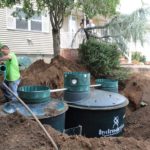Alternative Septic Systems You Must Know Before Planning Your Green Home
 Septic system solutions are often overlooked when planning the design or renovation of an environmentally friendly home. Much attention is spent on potential energy sources, such as solar or wind since energy provides a vital component for the house. But another essential component to consider for any green home is the septic system. Several issues can arise when choosing the best solution for your home.
Septic system solutions are often overlooked when planning the design or renovation of an environmentally friendly home. Much attention is spent on potential energy sources, such as solar or wind since energy provides a vital component for the house. But another essential component to consider for any green home is the septic system. Several issues can arise when choosing the best solution for your home.
Septic Systems Are a Common Choice for Environment-Friendly Homes
The United States Environmental Protection Agency says that one in five households in the US uses septic systems to treat wastewater. This traditional solution utilizes septic tanks containing bacteria to break down the waste which then produces gas and liquid. Then the fluid flows into a drain field, and there, the soil absorbs it back into the ground.
It’s a natural and straightforward solution, but may not always be the best solution depending on other factors, such as the drainage area size, and the condition of the soil. It’s best to learn about these before you begin the building process. You wouldn’t want to find out that the system you planned on using may not work because of various site conditions. The following two alternative septic systems are designed to solve these issues.
Filtration Systems Are Best for Smaller Drainage Areas
If there is not enough room for drain fields large enough to process waste, then a filtering system is a good option. Sand filters recirculate liquid waste before releasing it and can be located either below or above ground. This flexible placement can be helpful for some sites. Peat filtration can also be used to pass waste through peat which spreads it out more evenly. Waste material then breaks down in the bottom of the peat to proceed through the soil. This is also a helpful solution if the homesite does not have a flat area for drainage, such as a mountainous area for a cabin.
Aerobic Treatment Units Are Good for Soil Permeability Issues
Traditional septic systems break down pathogens in waste products with bacteria that is anaerobic, meaning it uses no oxygen. Then the material goes to drain fields, where the aerobic bacteria in the soil processes it further. But if the home doesn’t have porous soil, it cannot break down the material.
An aerobic system can help break down the pathogens before the waste reaches the drain fields. This is done by an additional tank which hosts aerobic bacteria, and with which the waste material must pass through. These systems require electricity to pump extra air through the tank, according to CabinLife.com, so this additional cost should be considered for this type of filtering system. Knowing these alternatives can help you in the planning process when designing your green home so that you better understand which solutions are most helpful in various situations. These systems require more maintenance, and equipment, but with regular maintenance by a licensed operator, the chance of expensive repairs and environmental damage are minimized.
Category: News